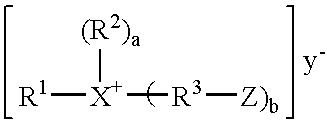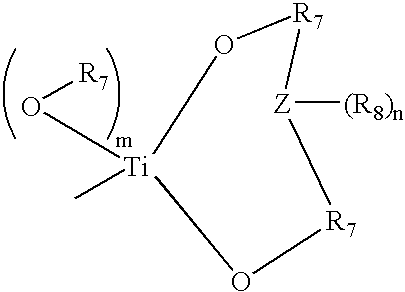Polymerizable macrocyclic oligomer masterbatches containing dispersed fillers
a macrocyclic oligomer and masterbatch technology, applied in the field of polymerizable polymer masterbatches containing dispersed fillers, can solve the problems of difficult economically to achieve this effect, difficult to remove heat deflection temperatures of polymer compositions, and exacerbate problems, so as to avoid excessive use of catalysts, reduce the effect of catalyst use and convenient removal
- Summary
- Abstract
- Description
- Claims
- Application Information
AI Technical Summary
Benefits of technology
Problems solved by technology
Method used
Image
Examples
examples 1-3
[0068] 430 parts of cyclic butylene terephthalate oligomers and 25 g of a cocoalkyl, methyl, bishydroxyethyl ammonium modified fluoromica clay (commercially available as Somasif™ MEE clay from Co-op Chemical) are charged to a flask equipped with a stirrer and gas adapter. The flask and its contents are heated under vacuum to 190° C. for one hour with gentle stirring, to dry the clay and oligomers. The mixture is then transferred to a baffled kettle equipped with a Cowles blade and heated to 190° C. with stirring at 3000 rpm. Another 920 parts of cyclic butylene terephthalate oligomers and 213 parts of the clay are gradually added to the kettle over 30 minutes, while maintaining the temperature near 190° C. during each addition. The total mixing time is 60 minutes. The resulting masterbatch material is poured into pans and placed in dry ice to rapidly solidify it. The solidified masterbatch material (Example 1) is then ground in a Wiley mill and dried overnight at 60° C. under vacuum...
example 4
[0071] A powdered cyclic butylene terephthalate oligomer is dry blended with masterbatch Example 1 at a 2:1 weight ratio and dried overnight at 90° C. under vacuum. The mixture is extruded in a Krupp-Werner Pfliederer Model ZSK-25 fully intermeshing co-rotating twin screw extruder, having a L / D ratio of 60 as a two-hole, 3-mm strand die. The mixture is starve-fed into the extruder using a screw-type powder feeder. The extrudate is water-cooled and palletized. The extruder is operated at 60 to 125 rpm, and the temperature profile is increased from 50° C. in the initial section to 240° C. over the latter sections of the extruder. Pellets produced in this manner are then subjected to solid state advancement in a vacuum oven at 200° C. for 8 hours. The resulting polymer is designated Example 4A.
[0072] Examples 4B and 4C are prepared in the same way, substituting masterbatch Examples 2 and 3, respectively, for the masterbatch used to make Example 4A.
[0073] Test bars are molded from the...
example 5
[0074] Somasif™ MEE clay (181.4 g), cyclic butylene terephthalate oligomers (714.34 g) and butyltin chloride dihydroxide (11.4 g) are combined with about 2 liters of methylene chloride. The mixture is stirred at room temperature for 6 hours, and transferred to a rotoevaporator to remove the majority of the solvent. A gelled mixture is obtained, from which the remaining solvent is removed by drying in a vacuum oven at 80° C. The resulting masterbatch product is a solid containing ˜20% by weight dispersed clay and 1.3% by weight of the catalyst. The masterbatch is ground to a fine powder.
[0075] The masterbatch is let down with additional cyclic butylene terephthalate oligomers at a 1:3 weight ratio by blending the powdered materials, to make a polymerizable mixture containing about 5% by weight clay, and subsequently polymerized in a reactive extrusion process to form a composite of the clay in the polymerized poly(butylene terephthalate). The REX process equipment consists of a co-r...
PUM
| Property | Measurement | Unit |
|---|---|---|
| Percent by mass | aaaaa | aaaaa |
| Percent by mass | aaaaa | aaaaa |
| Percent by mass | aaaaa | aaaaa |
Abstract
Description
Claims
Application Information
 Login to View More
Login to View More - R&D
- Intellectual Property
- Life Sciences
- Materials
- Tech Scout
- Unparalleled Data Quality
- Higher Quality Content
- 60% Fewer Hallucinations
Browse by: Latest US Patents, China's latest patents, Technical Efficacy Thesaurus, Application Domain, Technology Topic, Popular Technical Reports.
© 2025 PatSnap. All rights reserved.Legal|Privacy policy|Modern Slavery Act Transparency Statement|Sitemap|About US| Contact US: help@patsnap.com



